World Journal of Condensed Matter Physics
Vol.1 No.3(2011), Article ID:6935,15 pages DOI:10.4236/wjcmp.2011.13017
Development of Non-shrinking Soft Ferrite Composition Useful for Microinductors Applications
![]()
1Department of Physics, Kakatiya University,Warangal, India; 2Ceramic Composite Materials Laboratory, Department of Physics,
Sri Krishnadevaraya University, Anantapur, India.
Email: laxmisharmanarla@gmail.com
Received March 14th, 2011; revised June 16th, 2011; accepted June 25th, 2011.
Keywords: X-Ray Diffraction, Ferrite Composites, Initial Permeability, Microinductors, Stress Insensitivity, SEM Photographs
ABSTRACT
NiCuZn Ferrites are widely employed for many electronic applications, but can be replaced by MgCuZn ferrites owing to their superior properties like high initial permeability, high resistivity, low magnetostriction, environmental stability and low cost. Three series of NiMgCuZn ferrites were prepared by conventional sintering process. The formation of single phase in these ferrites was confirmed by X-ray diffraction. Initial permeability measurements on these samples were carried out in the temperature range of 30℃ - 400℃. The effect of the external applied stress on the open magnetic circuit type coil with these ferrites was studied by applying uniaxial compressive stress parallel to magnetizing direction and the change in the inductance was measured. The variation of ratio of inductance (DL/L)% increases upto certain applied compressive stress and there after it decreases, showing different stress sensitivities for different compositions of ferrites studied in the present work. With a view to develop stress insensitive NiMgCuZn ferrite, a low stress sensitivity composition among all the ferrites studied was chosen and different amounts of SiO2 were added to it and a series of ferrite compositions were prepared. The variation of ratio of inductance (DL/L)% with external applied compressive stress was examined. These results show that, in a particular composition of 0.05 wt% SiO2 added Ni0.3Mg0.3Cu0.1Zn0.3Fe2O4 ferrite exhibited stress insensitivity. It was noticed that addition of SiO2 was found to be effective in reducing the stress sensitivity. This was confirmed from the elastic behaviour studies at room temperature on these ferrite samples. These studies were carried out to develop a ferrite composition for its use as core material for microinductor applications.
1. Introduction
Microminiaturization of electronic circuits especially in the fields of mobile communication and information technology demands electronic components with very small size [1]. Recently, the surface mounting devices (SMD) such as microinductors and multilayer chip inductors have been rapidly developing for electronic applications. NiCuZn ferrites and MgCuZn ferrites are suitable for micro inductor applications. They find applications in the latest electronic products such as cellular phones, video cameras, note book computers, etc., and they require miniaturization. Recent technological developments concerning electrical devices demand higher performance of the inductor i.e. higher frequency application and further miniaturization. To satisfy these demands, NiCuZn ferrite [2-16] is best suited ferrite for these applications as Surface Mounting Device (SMDs). There are two types of SMD’s, multilayer chip and the wound chip inductors. Dram-type core is wire bound and moulded to resin, in order to stand up against mechanical shocks and moisture. During hardening, the resin shrinks and applies compressive stress to the core, which influences material behaviour. The shrinkage produces heavy stress on the core material and the inductance decreases [17,18]. This decrease in inductance results in much lower values of the moulded inductors and it will be a problem in mass production.
The initial permeability of a ferrite is very sensitive property to the external stress. Generally an external compressive stress around 1000 kg/cm2 is produced on the core during hardening of the resin [18]. This results in decreased values of inductance. This posses a big problem for highly inductive NiCuZn ferrites in mass production. Oshaia [17] reported that it is well known that PbO addition to the ferrite eliminates this inductance change. However, from an environmental point of view, lowering the amount of poisonous additive is desirable and thus tried to develop lesspoisonous stress insensitive NiCuZn ferrite. The mechanism of stress insensitivity was proposed by Kumagi of TDK, Japan [18]. According to him, internal tensile stress inside the grains resulting from a difference in thermal expansion coefficients, causes in stress sensitivity, when a grain boundary phase occurs with a thermal expansion coefficient larger than that of the grains, tensile stress are produced inside the grains under cooling conditions. Such tensile stress cancels external compressive stress to some degree. Thus, the cancellation of compressive stress shifts the stress sensitivity curve. Further more, not all compressive stress applies to the grains directly. Grain boundary phase divides external compressive stress, thus broadening stress sensitivity. Thus, preconditions for stress insensitivity are considered to be:
1) Applying tensile stress to the grains;
2) Absorbing the external stress applied to the grains.
To apply tensile stress to the grains, additives with a small thermal expansion coefficient is necessary. In addition, so as to apply the stress effectively, the additives needs must wet the matrix well and he tried three different oxides that have low melting points, PbO, Bi2O3 and V2O5 etc., as additives. From, the environmental point view, Bi2O3 is the best additive among the three additives and tried to improve the stress insensitivity by adding Bi2O3. After many examinations he found that the combined addition of Bi2O3, SiO2 and MgO was the additive complex which gives best result. Probably, the reason for this improvement is that the external stress was absorbed by rigid elements SiO2 and MgO. Furthermore, complex addition not only improves stress insensitivity, but it also improves flat temperature dependence of inductance which is very important for inductors. In view of this in this laboratory the stress sensitivity of a series of NiCuZn ferrites for their use as micro-inductor core materials was studied and achieved the stress insensitivity in those ferrites [19] and could produce stress insensitivity by adding suitable additives.
It was reported that electromagnetic properties of the multilayer chip ferrite components [9,18,20-22] are influenced by the internal stresses and the diffusion of Ag buried in ferrite [23-30]. As the magnetostriction of MgCuZn ferrites is lower than that of NiCuZn ferrites, it was expected that the multilayer chip inductor using MgCuZn ferrite [31] would show higher magnetic properties than that using NiCuZn ferrite. Therefore MgCuZn ferrites with the low sintering temperature have been developed as the materials for the multilayer chip ferrite components. Under a compressive stress, the change in permeability of low temperature sintered MgCuZn ferrite was lower than that of low temperature sintered NiCuZn ferrite. Moreover, one might expect that the multilayer chip inductor using low temperature sintered MgCuZn ferrite would show a higher inductance than the chip using low temperature sintered NiCuZn ferrite. It is thought that low temperature sintered MgCuZn ferrite have high potentialities.
MgCuZn ferrite is also a pertinent magnetic material for wide range of applications owing to its superior properties at high frequency, high resistivity, low magnetostriction, fairly high Curie temperature, environmental stability and low cost [27-34]. It is believed that the increase of permeability can be achieved by decreasing the magnetostriction constant. In view of this, in the present investigation three series of NiMgCuZn ferrite and temperature variation of initial permeability and stress sensitivity of inductance were studied.
2. Brief Review of the Experimental Work Carried out on the Stress Sensitivity
Stress sensitivity of inductance in NiCuZn ferrites was carried out by Ramamanohar Reddy et al., [19] and observed that stress sensitivity is more in the case of iron rich and stoichiometric iron samples while in the case of iron deficient samples the stress sensitivity was found to be less. The stress sensitivity in Ni-Mn, Ni-Mn-Co and Ni-Mn-Co-Cu ferrites was studied by Kaczkowski [35] and concluded that the high stress sensitivity was observed for the ferrites with the smallest magnetocrystalline anisotropy.
The effects of chemical composition and micro structure on stress sensitivity of magnetic properties with applied stress in Ni-Mg-Cu-Zn ferrite materials were investigated, by Kanada et al., [36] and reported that on application of stress sensitivity was reduced.
Effects of stress and on microstructure in Mn-Zn ferrite for power applications were carried out by Bienkowski et al., [37]. Manganese substituted cobalt ferrite magnetostrictive materials for magnetic sensor applications were carried out by Paulsen et al., [38]. Mechanical and electrical properties of Ni0.65Zn0.35CuxFe2-x O4 ferrites were carried out by Abd.El-Ati and Tawfik [39]. The dependence of the rectangular hysteresis loop on the external stress in manganese-magnesium and manganese ferrites were reported by Czecnoslovak [40]. Jong [41] studied the control of stress sensitivity in gadolinium Yttrium iron garnets.
Enokidoy et al., [42] have studied the effects of additives on the stress and temperature dependence of in inductance NiCuZn ferrite.
Effect of glass addition and quenching on the relation between inductance and external compressive stress in Ni-Cu-Zn ferrites-glass composites were reported by Yamaguchi and Shingawa [43] and the effect of quenching temperature on the stress-inductance characteristic is discussed in terms of the bending strength and fracture mode of the composites, creep and micro crack formation during quenching are proposed to be responsible factors. Meharabi and Mintz [44] studied the influence of tempering on impact behaviour of quenched and tempered steels with low hardenability. Evaluations of mechanical properties of magnetic materials using non-destructive method were carried out by Yang et al., [45].
Vaughn et al. [46,47] studied ferrite phase shifters using stress-insensitive garnet materials.
Developments of stress-insensitive ferrite were carried out by Ikeda and Kumagi [48] and concluded that the sensitivity of the magnetic property to the external stress in NiCuZn ferrite was examined from the relationship between stress and permeability. In the production process of inductors, external stress is applied to the NiCuZn ferrite core by molding the resin, which is a protection against humidity or shock. As the permeability of NiCuZn ferrites are very sensitive against the external stress, the inductance of inductors changes very easily by the applied stress. This change has been recognized as the barrier to produce the inductors with a narrow inductance tolerance and found the best way to control the stresssensitivity of permeability in NiCuZn ferrite by the addition of oxide such as SiO2, and the inductance change can be completely explained from the residual stress caused by the difference of coefficients of linear thermal expansion between spinel phase (magnetic) and second phase (non-magnetic). By this process, they succeeded in developing “stress-insensitive ferrite” and the mass production of the inductors with a narrow inductance tolerance.
Nakano et al. [49] studied the development of low temperature fired NiCuZn ferrites and studied the high performance multilayer chip inductors and concluded that the controlling stress by the internal Ag-conductor and CuO1-x/Ag on ferrites grain boundary is most important key point for high performance multilayer chip ferrites as well as the chemical composition of ferrite. The stress insensitive ferrite for micro inductors was carried out by Kumagi and Ikeda [50].
Nakano et al., [51] have studied the magnetic properties of Mg-Cu-Zn ferrites under stress were investigated and compared with Ni-Cu-Zn ferrite under a compressive stress. They observed that the change in permeability with stress of low temperature sintered MgCuZn ferrite was lower than that of low temperature sintered NiCuZn ferrite. They have also shown that the multilayer chip inductor using low temperature sintered MgCuZn ferrite would show a higher inductance than the chip using low temperature sintering NiCuZn ferrite.
The effect of SiO2 on the bending strength of NiCuZn ferrite was investigated by Aoki et al. [52]. They found that the bending strength of NiCuZn ferrite was increased by the addition of SiO2. The NiCuZn ferrite with SiO2 addition, showed a structure with smaller and more uniform grain size than non-addition of SiO2. The improvement in the bending strength of NiCuZn ferrite were attributed to the control of grain growth by Zn2SiO4 and the residual stress caused by the difference of coefficients of liner thermal expansion between ferrite phase and Zn2SiO4 phase. Kuroda [53] studied the phenomenological plasticity model accounting for hydrostatic stress sensitivity and vertex-type of effect.
The numerical simulation of the large elastic-plastic deformation behavior of hydrostatic stress-sensitivity in solids and numerical analysis and large strain elasticviscoplastic behaviour of hydrostatic stress-sensitive metals were carried out by Bruonig [54,55]. Bruonig et al. [56] also studied the numerical simulation of the localization behaviour of hydrostatic stress-sensitivity in metals.
Aoki et al. [57] carried out the studies on the bending strength of sintered MgCuZn, NiCuZn and MnZn ferrites. They found that the much residual carbon content affects the bending strength of these sintered ferrites. Nakahata et al. [58] studied the low temperature MgCuZn ferrites.
Nakano et al. [59] studied the development of low temperature NiCuZn ferrites and study of high performance for multilayer chip ferrites and observed that the controlling stress by the internal Ag-conductor and CuO1-x/Ag on ferrites grain boundary is most important for high performance multilayer chip ferrites as well as the chemical composition of ferrite.
High strength NiCuZn ferrites used for surface mounting devices were studied by Murayamna et al. [60]. Temme et al. [61] studied the lithium ferrites for microwave devices. The effect of microstructure on residual stress-prodcuing a dreleasing mechanisms in NiCuZn ferrites by a non-destructive stress evealuation method using magnetic measurements was investigated bu Mian and Yamaguchi [62].
From the above review, the author noticed that the experimental work carried out on nickel magnesium copper and zinc ferrites is very scanty. In view of this, the author has taken up a systematic investigation on the effect of external stress on the inductance change in nickel magnesium copper and zinc ferrites and results are presented in next section.
3. Experimental Details
In the present investigation, the three series of NiMgCu Zn ferrites were synthesized
Series I: NixMg0.6-xCu0.1Zn0.3Fe2O4 where x varies from 0.0, 0.1, 0.2 and 0.3
Series II: Ni0.3MgxCu0.1Zn0.6-xFe2O4 where x varies from 0.1, 0.2 and 0.3
Series III: Ni0.35MgxCu0.05Zn0.6-xFe2O4 where x varies from 0.0, 0.1and 0.2
3.1. Preparation of Ferrites
In the present investigation, the NiMgCuZn ferrites were prepared by employing conventional solid state reaction route by mixing analytical grade NiO, MgO, CuO, ZnO and Fe2O3 in stoichiometric proportions. These oxides were weighed and intimately mixed in appropriate proportions and ground together using agate mortar for 8 hours. This mixture was pressed into a cake and presintered at 800℃ for 12 hours taking enough care to avoid the evaporation of zinc and is cooled to room temperature. The pre-sintered cake was crushed and was ground in agate mortar to obtain fine particle size. This powder was sieved to obtain uniform particle size.
These mixed powders were pressed with the help of the hydraulic press applying a pressure of 25 kN using a high carbon high chromium steel die into the required shape. The binder used in the present work is 2% polyvinyl alcohol, dissolved in the water. Occasionally stearic acid dissolved in the acetone was also used as lubricant to prevent sticking of powder to the walls of the die to get the desired shape of the cylinders of diameter 10 × 10-3 m and length nearly 20 × 10–3 m at 150 MPa which is the requirement shape of the experimental techniqueThe green powders of the ferrites were pressed in suitable dies and they were loaded on a ceramic block containing ‘V’ shaped grooves to prevent bending of the samples during the final sintering process at high temperatures. After loading the ceramic block in to the furnace, the temperature of the furnace was raised to 110℃ in a period of 1 hr and maintained at 110℃ to remove the residual water content if any from the samples. Then the furnace temperature was raised to 800℃ at the rate of 80℃/hr and maintained there for one more hour for the burning of binder used in the samples. Lastly, the final temperature of 1250℃ was achieved at the rate of 100℃/hr. A soaking time of 3 hrs is maintained and later, the samples were cooled to room temperature at the rate of 80℃/hr. After cooling, the samples were removed from the furnace. Enough care was taken to avoid the evaporation of zinc during the sintering process. The samples were removed from the furnace and surfaces were ground to remove segregated layer if any and the measurement of physical parameters and characterization was carried out and the details are presented in the next section. All the samples were structurally characterized using Philips high resolution X-ray diffraction system (PM 1730 X-ray diffractometer). Microstructures of sintered samples were investigated using JOEL (Model HSM 35CF, Japan) scanning electron microscope.
The initial permeability, mi of these ferrite torroids were evaluated using the standard formulae from the inductance measurements carried out at 1 kHz using computer controlled impedance analyzer (Hioki Model 3532-50 LCR HiTester, Japan). These measurements were carried out in the temperature range of 30 to 400℃. In order to study the effect of external stress, uniaxial compressive stress parallel to the magnetizing direction was applied to the cylindrical shaped ferrite cores using uniaxial press system. The stress magnitudes were varied from 0 to 10 MPa. The change in inductance was measured using the above mentioned LCR HiTester by employing 100 - 120 turns coil wound on each cylinder. The composite resonator technique [11] was employed for the room temperature longitudinal elastic modulus measurements.
4. Results and Discussion
Table 1 shows the details of various oxides present in the three series of NiMgCuZn ferrites in mole percent.
The typical X-ray diffractograms of NiMgCuZn ferrite samples of all the three series are shown Figures 1(a)-(j) depicts the typical X-ray diffractogram of 0.25 wt% SiO2 added to sample-D. The X-ray diffraction analysis of the ferrite samples studied in the present work revealed the formation of all the peaks i.e. (220), (311), (222), (400), (422), (511) and (440) is the evident that the sintered samples contains only spinel phase cubic structure, no second phase was observed. Typical SEM patterns Sample A, Sample D and the 0.25 wt% SiO2 added Sample D are shown in the Figures 2(a)-(c) respectively.
An examination of the SEM photographs reveals that the grain morphologies of the mentioned samples are different. A close examination of Figure 2(c)) reveals that there are large grains in this sample. Generally, large grained samples show high initial permeability magnitude. Addition of SiO2 to pure ferrite forms Zn2SiO4 as a second component as evidenced from the extra lines in the X-ray diffraction Figure 1(j) also it may be pointed out here that this second phase is not visible in the scanning electron micrograph shown in Figure 2(c)). It

Table 1. Composition of various oxides present in NiMgCuZn ferrites in mole percent.
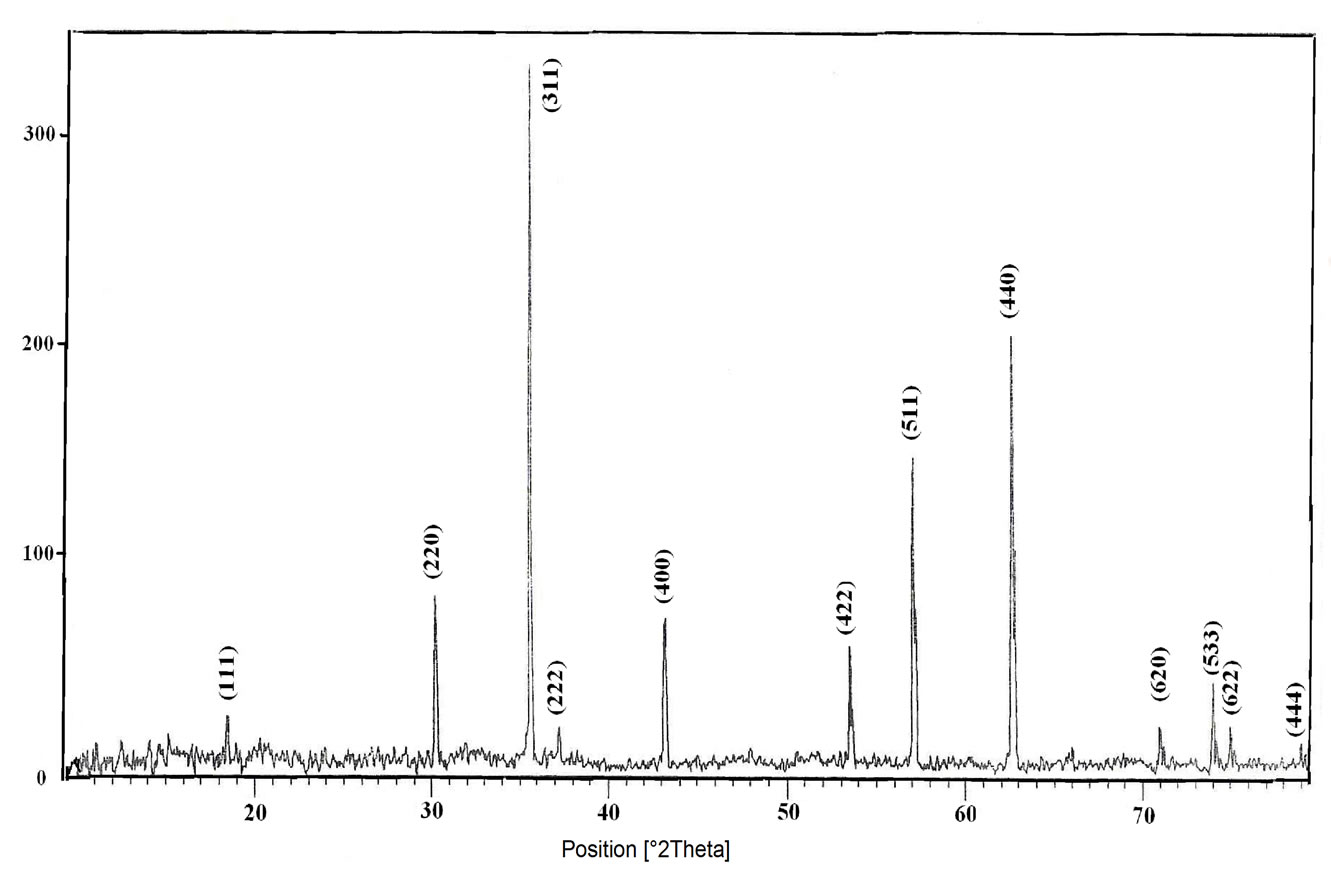 (a)
(a)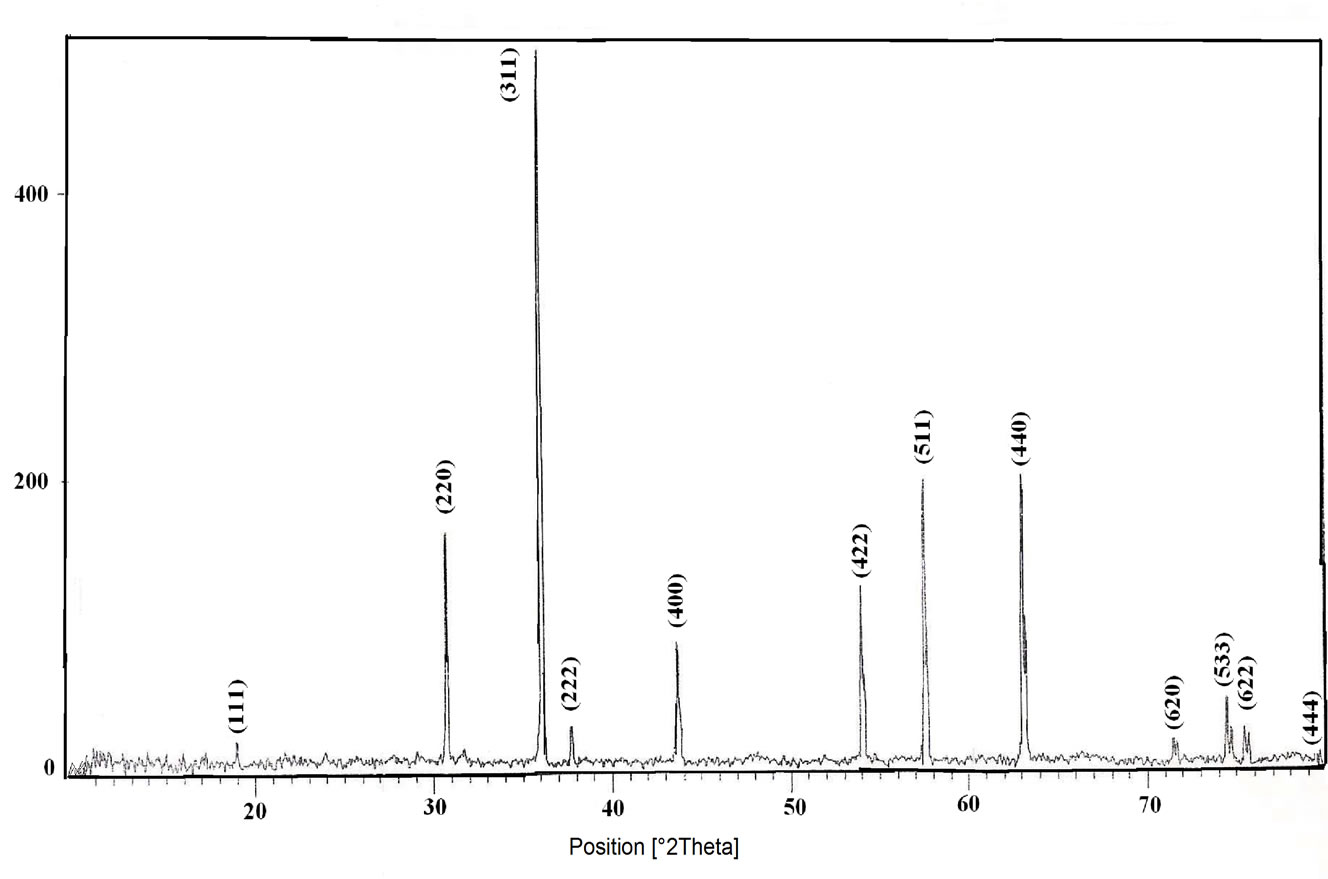 (b)
(b) (c)
(c)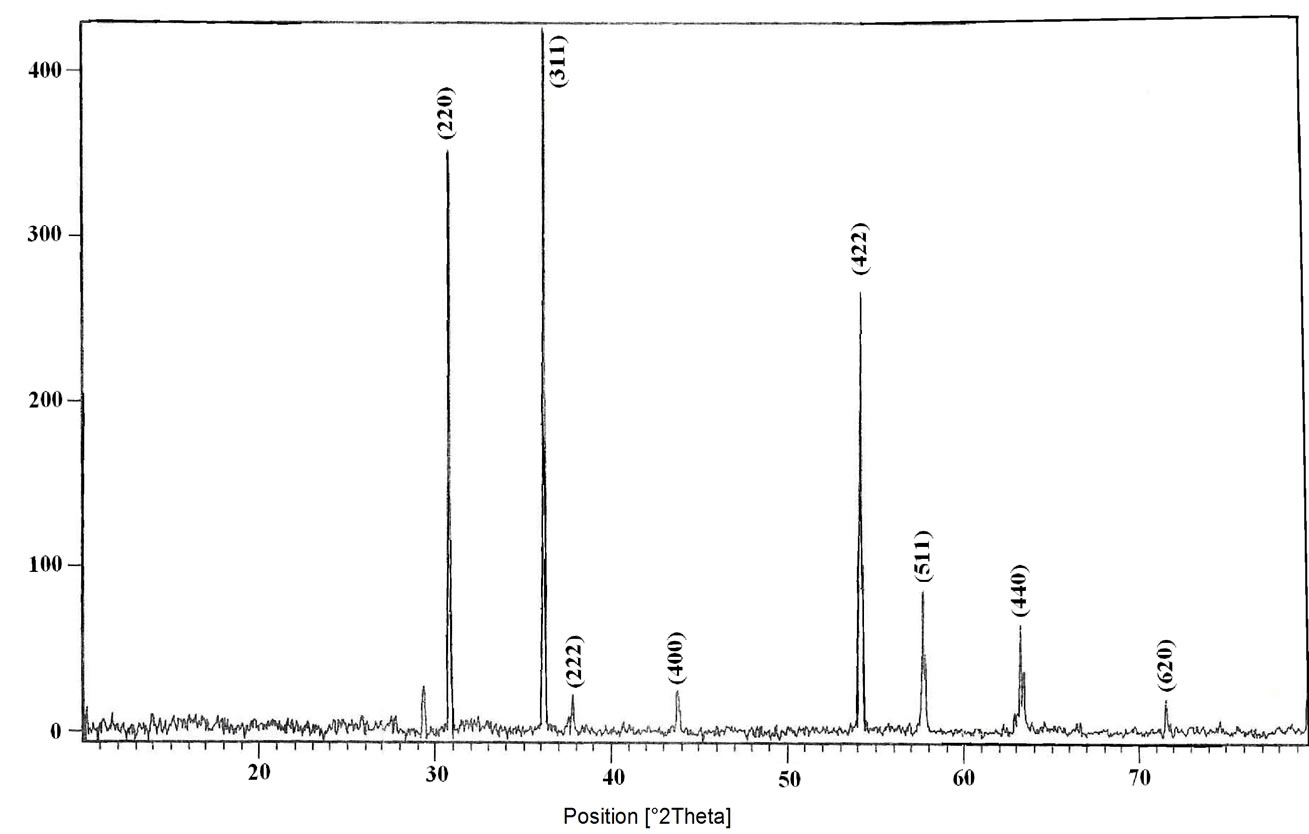 (d)
(d)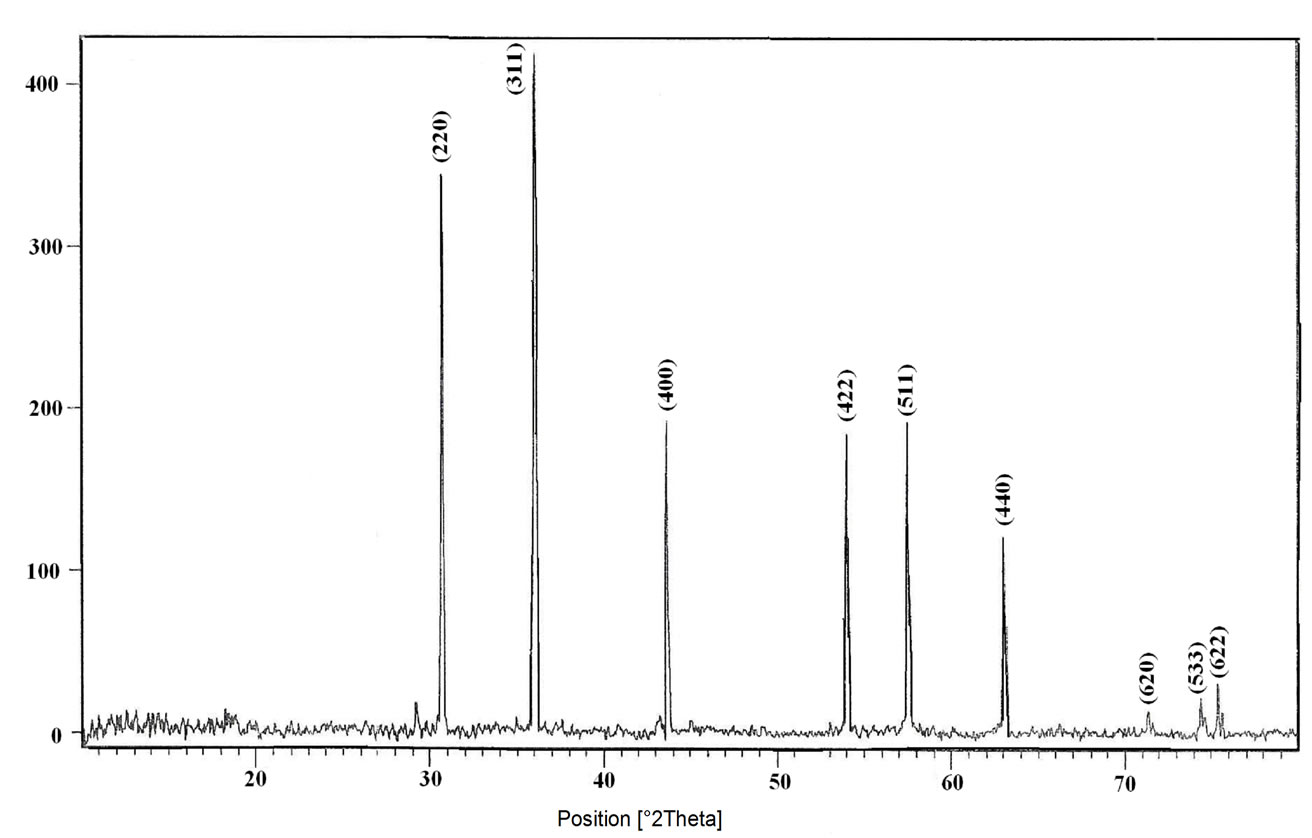 (e)
(e)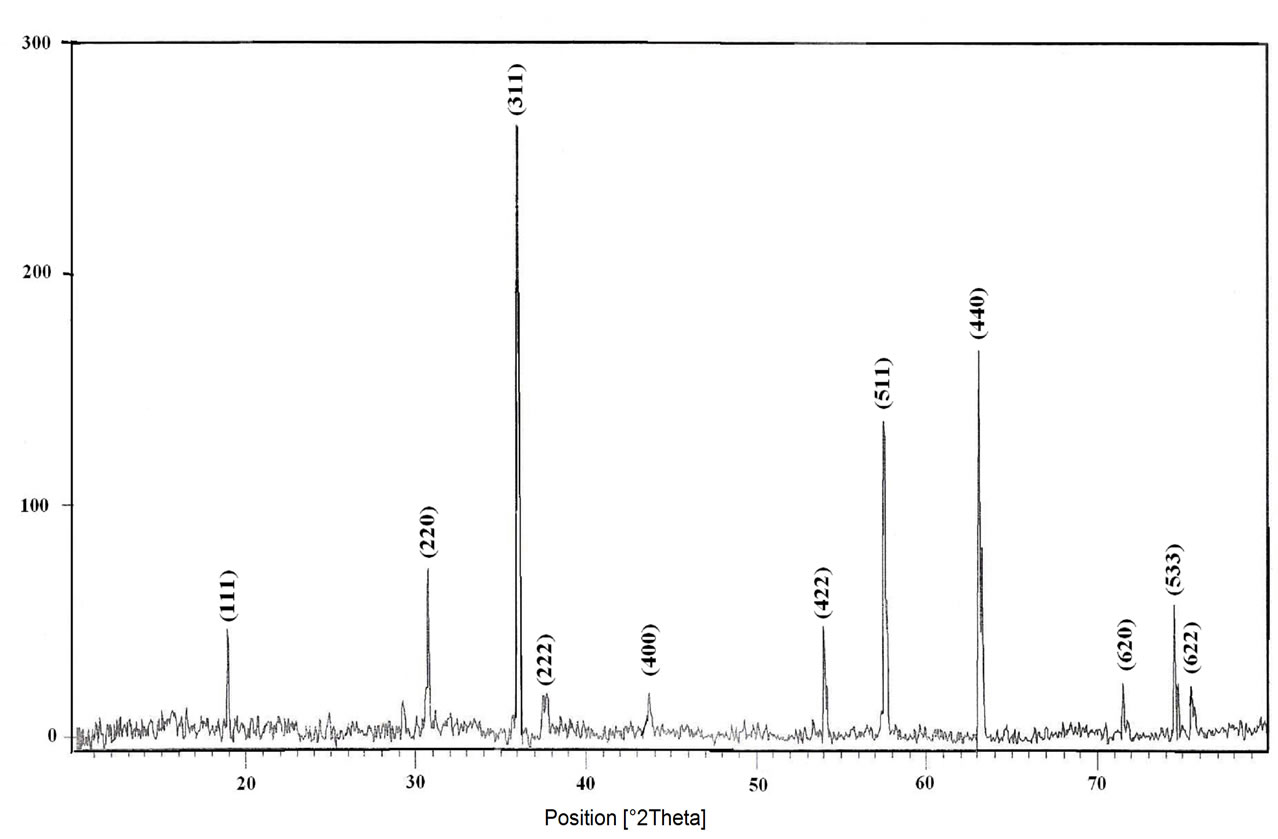 (f)
(f) (g)
(g)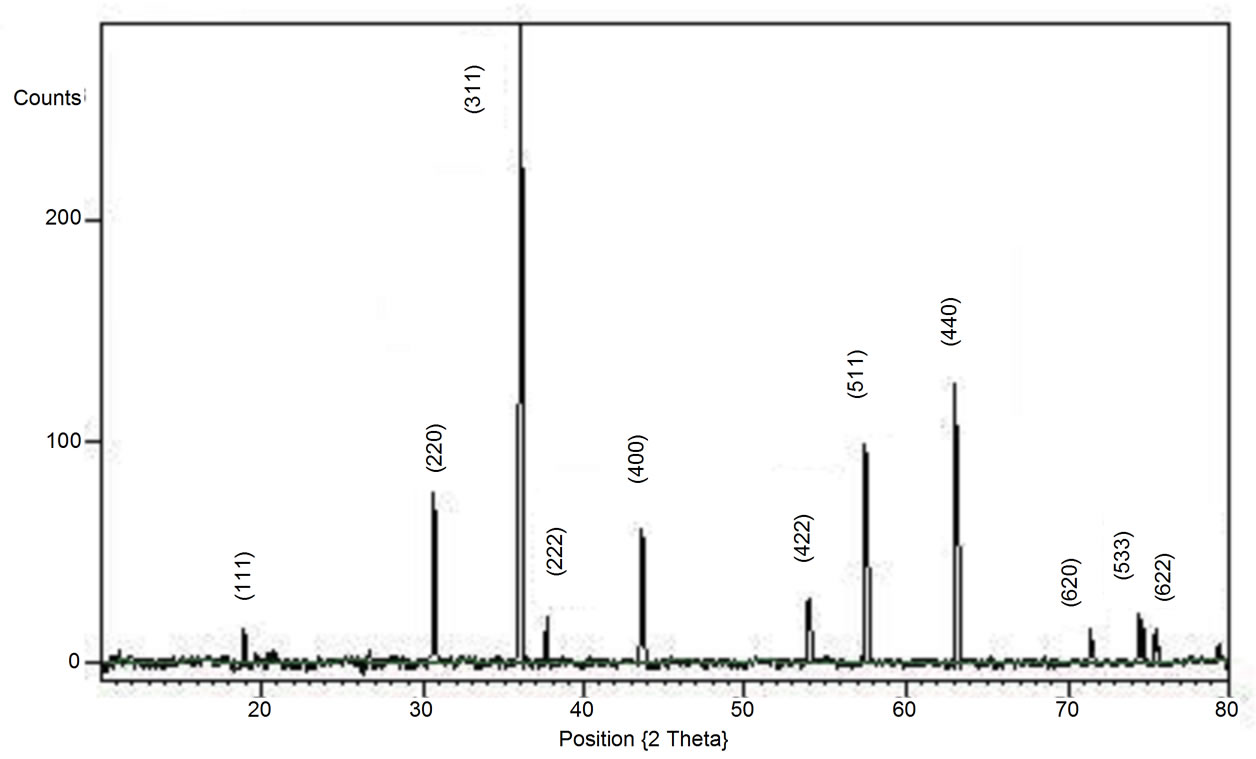 (h)
(h) (i)
(i) (j)
(j)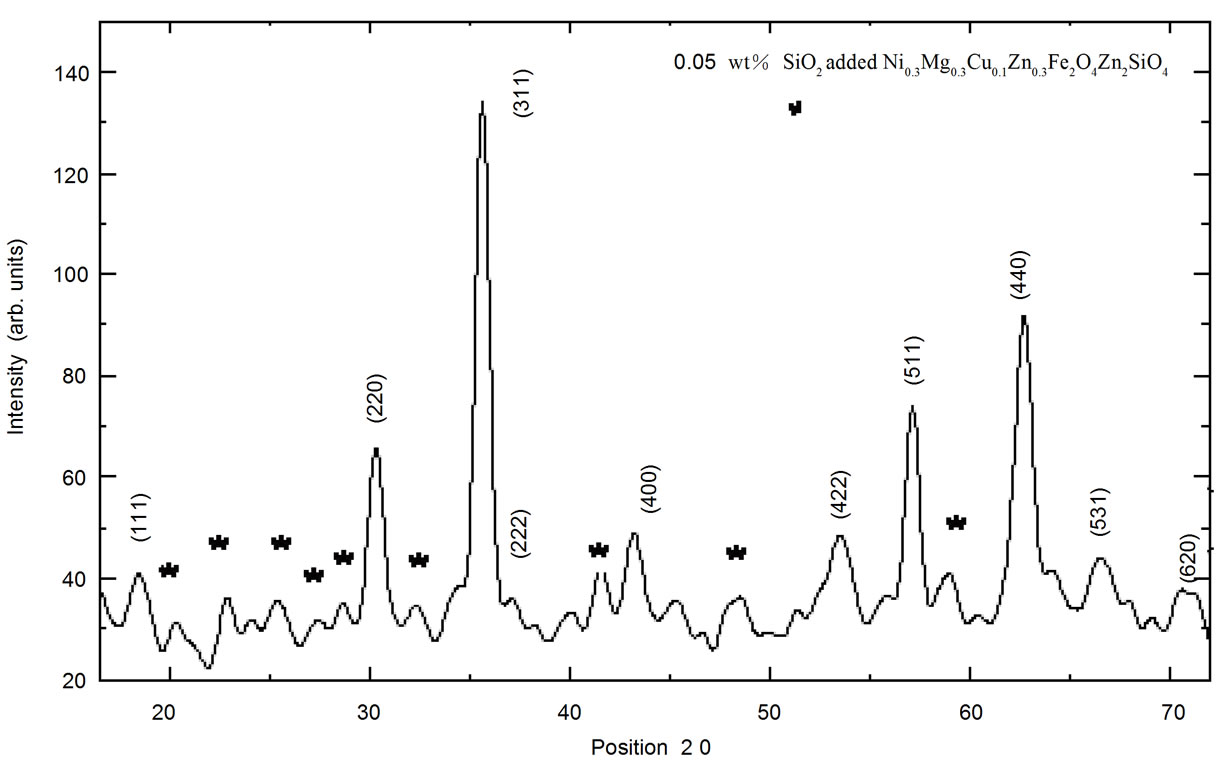 (k)
(k)
Figure 1. (a) X-ray diffractogram of Sample A; (b) X-ray diffractogram of Sample B; (c) X-ray diffractogram of Sample C; (d) X-ray diffractogram of Sample D; (e) X-ray diffractogram of Sample E; (f) X-ray diffractogram of Sample F; (g) X-ray diffractogram of Sample G; (h) X-ray diffractogram of Sample H; (i) X-ray diffractogram of Sample I; (j) X-ray diffractogram of Sample J; (k) X-ray diffractogram of SiO2 added Sample D.
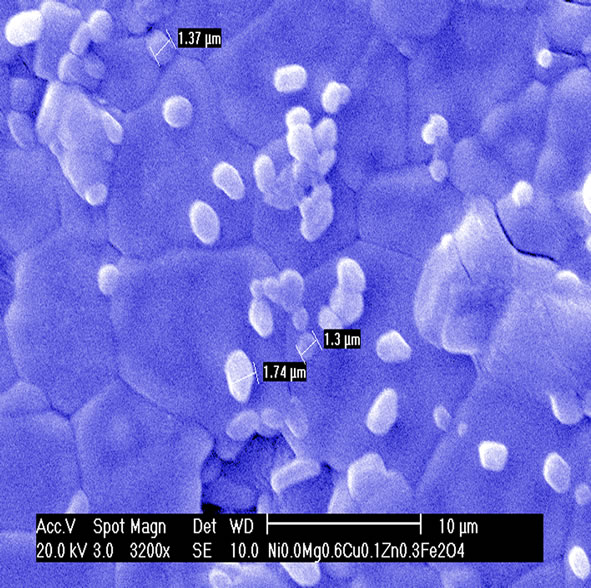 (a)
(a)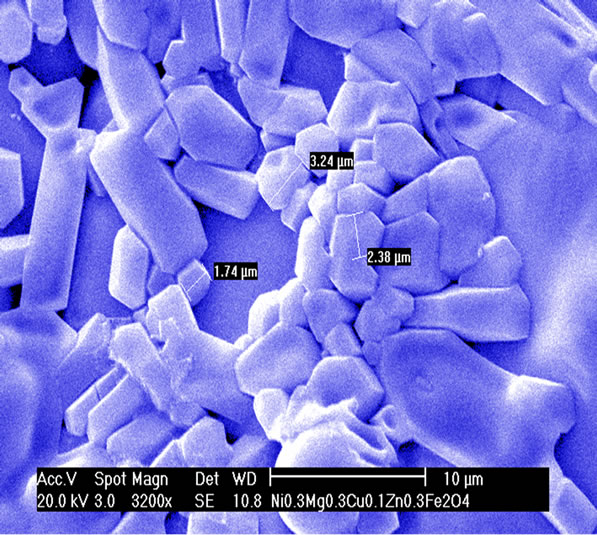 (b)
(b)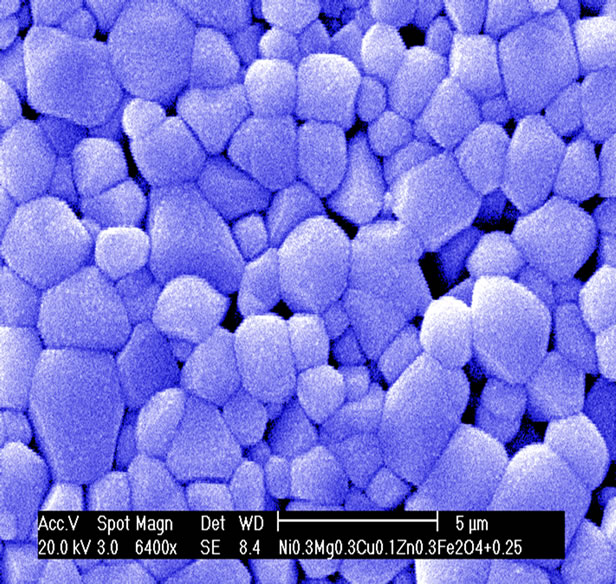 (c)
(c)
Figure 2. Scanning electron micrographs of (a) Sample A; (b) Sample D; (c) SiO2 added Sample D.
appears that Zn2SiO4, a non-magnetic material seems to cover the grains of the ferrite to act mechanically against the external compressive stress and act as a buffer material in reducing the stress sensitivity considerably.
(a) Series I
Table 2 shows the values of compositional dependence of initial permeability at room temperature at 1 KHz. The variation of initial permeability (mi) with temperature, the composition in which there is no nickel content i.e., Sample A shows a value of initial permeability (mi = 585 at 30℃) and Curie temperature Tc = 230℃, while the Sample D shows an initial permeability magnitude of (mi = 518 at 30℃) and has a high Curie temperature Tc = 300℃. It can be inferred from this that the magnitudes of initial permeability at room temperature are moderate high.
Figure 3 shows the graphically represented data of the ratio of inductance change (DL/L)% as a function of applied compressive stress for Sample A. An examination of the Figure 3 indicates that (DL/L)% increases up to a certain applied stress and there after, it decreases, showing different stress sensitivities for different compositions.
It is clear from figure that ratio of change in inductance (DL/L)% reaches a peak value and then starts decreasing with increasing applied compressive stress for all the compositions, but it is found to be less stress sensitive in composition Sample D In all the samples studied in this series the (DL/L) % values are positive in the entire region of the applied stress applied. Exactly, similar behaviour was noticed by Kanada et al. [36] in NiMg CuZn ferrites at 4 Mpa.
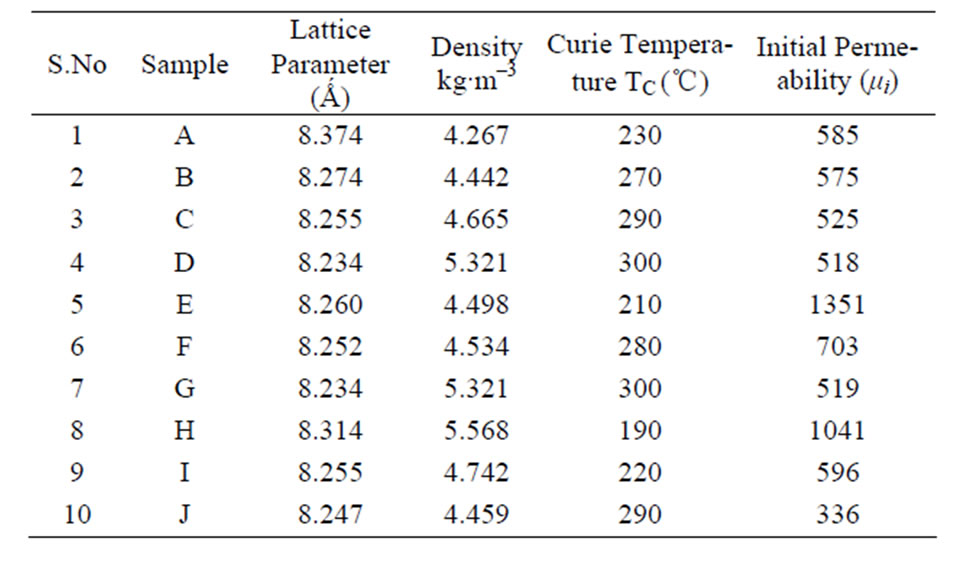
Table 2. Lattice parameter, density, Curie temperature and Initial Permeability of all the three series of NiMgCuZn ferrites at room temperature.
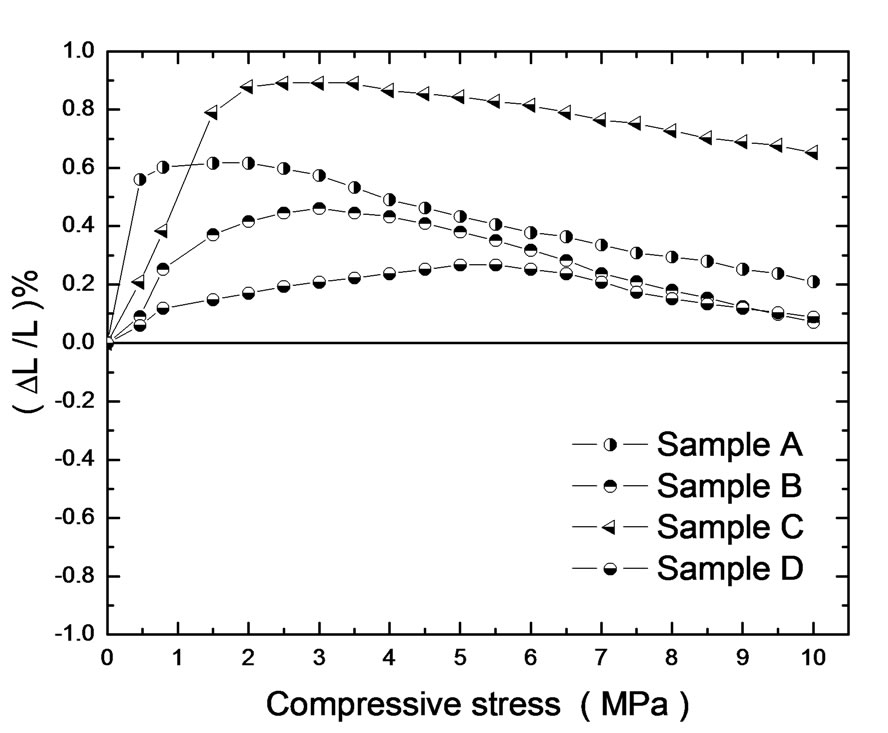
Figure 3. Variation of ratio of change in inductance (DL/L)% as a function of applied compressive stress in Series I system.
These curves show peak values of (DL/L)% at different magnitudes of external compressive stresses. As the elastic modulus of the ferrite increases the material becomes less compressive and the stress variation is found to decrease. This is in agreement with the observations made by Kumagai and Ikeda [18]. For small compressive stresses, the stress raises initial permeability with negative magnetostriction and for large tensile stresses the permeability decreases [63]. The variations of permeability with applied stress can be attributed to the magnetostrictive contributions of varied amounts of nickel and iron present in these samples.
(b) Series II
The initial permeability (mi) for Sample E shows high value of initial permeability (mi = 1351 at 30℃) and Curie temperature (Tc = 210℃), while the sample Sample G has fairly high Curie temperature (Tc = 300℃), and shows low permeability value mi = 518 at room temperature presented in Table 2
The variation of ratio of inductance change (DL/L)% as a function of applied compressive stress is shown in Figure 4.
An examination of the Figure 4 it is clear that (DL/L)% increases up to a certain applied stress and there after, it decreases, showing different stress sensitivities for different compositions.
(c) Series III
The values of initial permeability of this series at room temperature is given in Figure 2 which shows a high permeability i.e. 1041 for sample H and low value i.e. 336 for Sample J The variation of ratio of inductance change (DL/L)% as a function of applied compressive stress is shown in
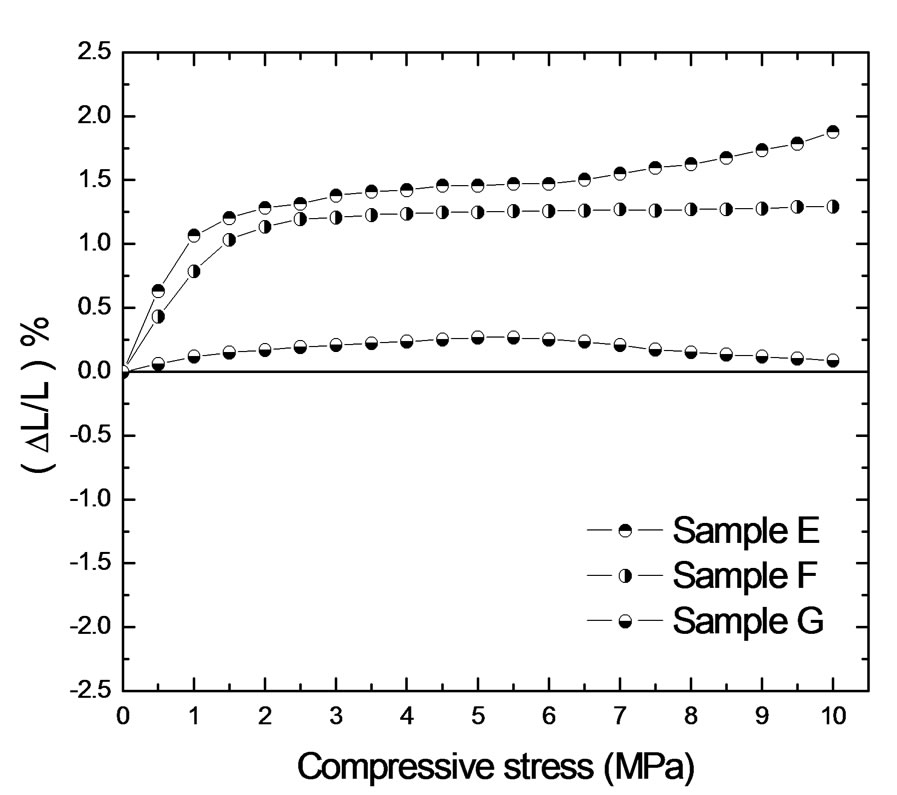
Figure 4. Variation of ratio of change in inductance (DL/L)% as a function of applied compressive stress in Series II system.
Figure 5. From this it is clear that (DL/L)% increases up to a certain applied stress and there after, starts decreasing, showing different stress sensitivities for different compositions. It can be seen from Figure 5 for x = 0.0 (DL/L)% values are negative in the entire region of stress applied while for x = 0.1 and 0.2 (DL/L)% values are positive in the entire region of stress applied.
Among all the three series studied in the present work, it can be noticed that in Sample D the stress sensitivity is found to be less. It is thought that in view of the stress insensitivity could be achieved in these above mentioned ferrite by employing suitable additives.
However, the stress sensitivity in these ferrites is fairly low compared to NiCuZn ferrites [19]. These (DL/L)% curves with applied compressive stress show peak values [36] at different magnitudes of external compressive stress. These variations of permeability with applied compressive stress can be attributed to the magnetostrictive contributions of varied amounts of nickel (ls = –26 × 10–6), and iron (ls = –19.5 × 10–6) present in these samples [48]. For small compressive stresses, the stress raises initial permeability with negative magnetostriction and for large tensile stresses the permeability decreases [63].
5. Achievement of Stress Insensitivity of Ferrites for Micro-Inductor Applications
To examine the effect of various additives on the reduction of stress sensitivity of these NiMgCuZn ferrites, addition of various additives like MgO, Bi2O3B2O3 and SiO2 were examined. Among these additives, it was found that addition of SiO2 was found to be beneficial effect in reducing the stress sensitivity in these ferrites.
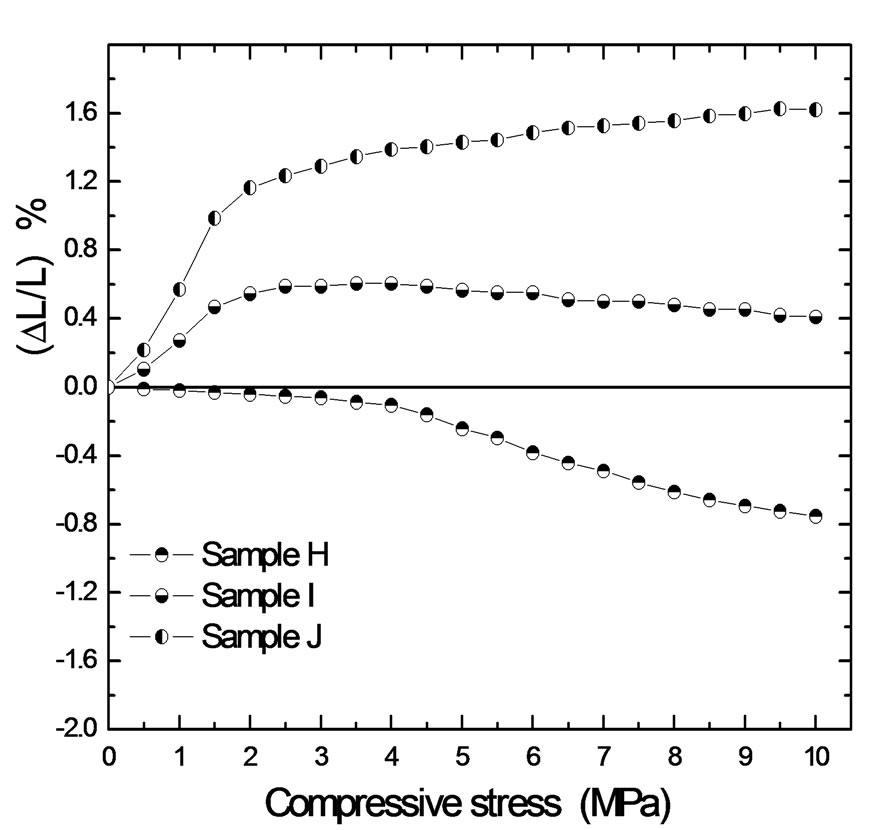
Figure 5. Variation of ratio of change in inductance (DL/L) % as a function of applied compressive stress in Series III system.
Hence to reduce the stress sensitivity in these NiMg CuZn ferrites, the composition from Series I (viz., Sample i.e. Ni0.3Mg0.3Cu0.1Zn0.3Fe2O4 in which stress sensitivity is found to be less, was chosen and different amounts of SiO2 (0.05 wt% to 2 wt%) were added to it as an additive and a series of ferrites were prepared. The stress sensitivity in these ferrites was examined.
Figure 6 shows the temperature variation of initial permeability µi at 1 kHz in the temperature range of 30 to 350℃ of pure ferrite sample D and those samples obtained by addition of various contents of SiO2 to it. At room temperature, the magnitude of initial permeability mi vary between 530 and 340 with increasing content of SiO2. It can be noticed from the figure that the magnitude of Curie temperature does not change much with addition of SiO2.
To examine the effect of addition of SiO2 (from 0.05 wt% to 2 wt%) on the variation of ratio of inductance change (DL/L)% as a function of compressive stress in the sample D and the samples obtained by adding different contents of SiO2 to it, the (DL/L)% measurements were carried out with increasing compressive stress and the data is graphically in Figure 7. It can be noticed from Figure 7 that the ratio of (DL/L)% increases with increasing applied stress in pure ferrite. As the addition of SiO2 increases, (DL/L)% magnitude changes from positive to negative. The (DL/L)% decreases slowly at lower stress magnitudes and at higher stress magnitudes the fall in (DL/L)% is more in SiO2 added samples. However, it can be observed that the variation of ratio of inductance change (DL/L) % is almost negligible within the experimental error in the case of the sample with 0.05 wt% SiO2. That is, the ferrite becomes stress insensitive at this composition.
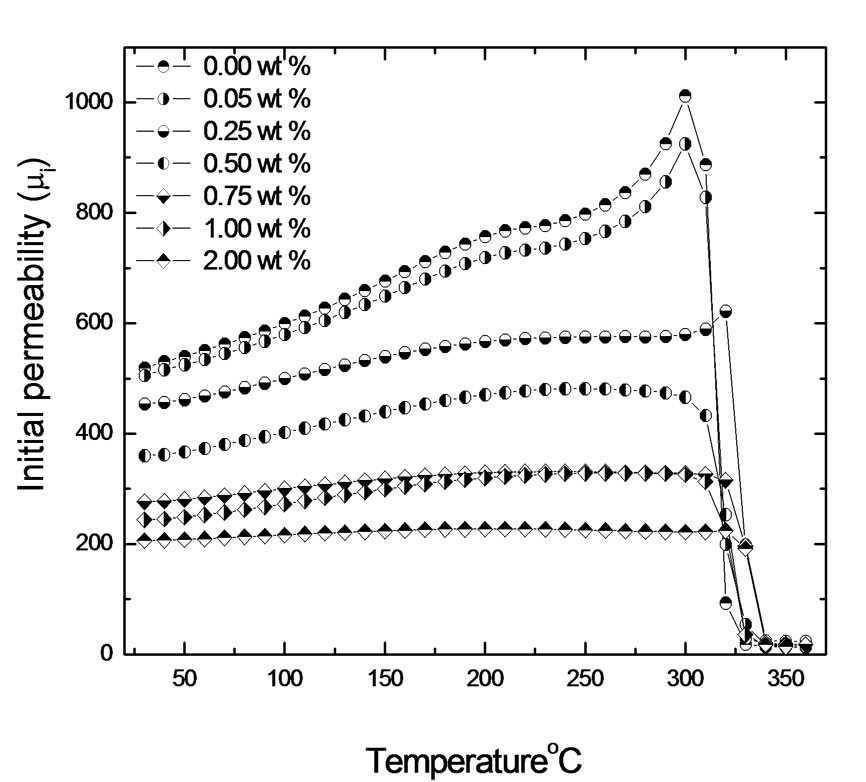
Figure 6. The variation of initial permeability (mi) at room temperature for SiO2 added Sample D system at 1 kHz.
In order to understand the stress sensitivity behaviour, measurements of longitudinal modulus (L) were carried out on sample D and those obtained by adding various amounts of SiO2 as additive. The variation of longitudinal modulus L, as a function of SiO2 concentration is shown in Figure 8.
An examination of the Figure 8 reveals that when SiO2 is added to the ferrite sample the modulus increases sharply and remains fairly constant at higher magnitudes of SiO2. This shows that the addition of SiO2 to ferrite sample enhances the modulus indicating that the sample is becoming stress insensitive. Addition of SiO2 to pure ferrite forms Zn2SiO4 as a second component as evidenced from the extra lines in the X-ray diffraction Figure 1(j). It may be pointed out here that this second phase is not visible in the scanning electron micrograph shown in Figure 2(c). It appears that Zn2SiO4, a

Figure 7. Variation of ratio of change in inductance (DL/L) % as a function of applied compressive stress in SiO2 added Sample D system.
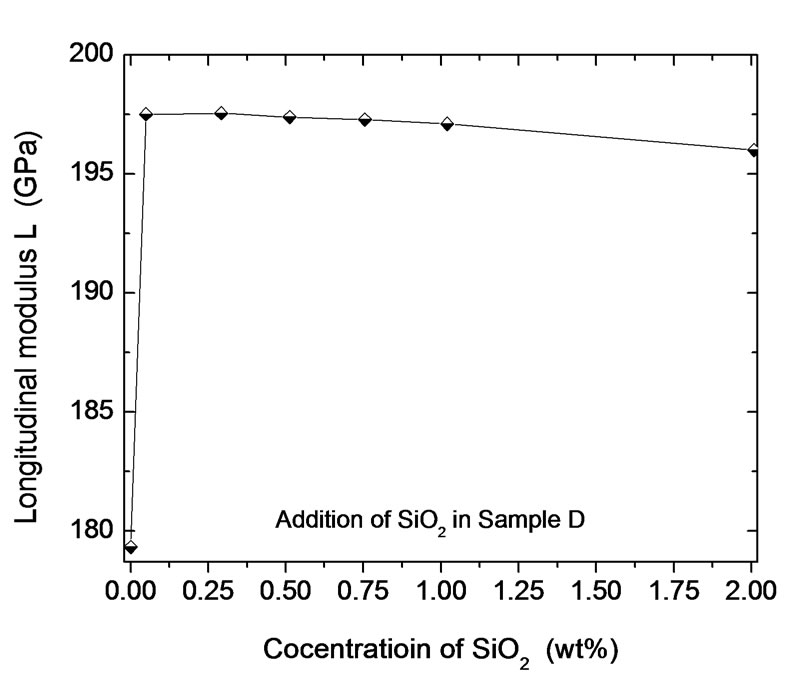
Figure 8. Variation of longitudinal modulus (L) as a function of SiO2 concentration in Sample D system.
non-magnetic material seems to cover the grains of the ferrite to act mechanically against the external compressive stress and act as a buffer material in reducing the stress sensitivity considerably.
The work is aimed at obtaining nickel magnesium copper and zinc ferrites with constant magnetic permeability and stress insensitive with various additives like MgO, Bi2O3 B2O3 and SiO2 were examined. Among the additives mentioned above, it was found that addition of SiO2 has beneficial effect in reducing the stress sensitivity in these ferrites. The permeability is reasonably high for SiO2 concentration for 0.05wt%. Addition of SiO2 to NiMgCuZn ferrite causes reduction of stress sensitivity. In the present work on NiMgCuZn and Pure NiCuZn ferrites it is found that the addition of 0.05wt% SiO2 in sample D produces stress insensitivity.
6. Comparison of the Results
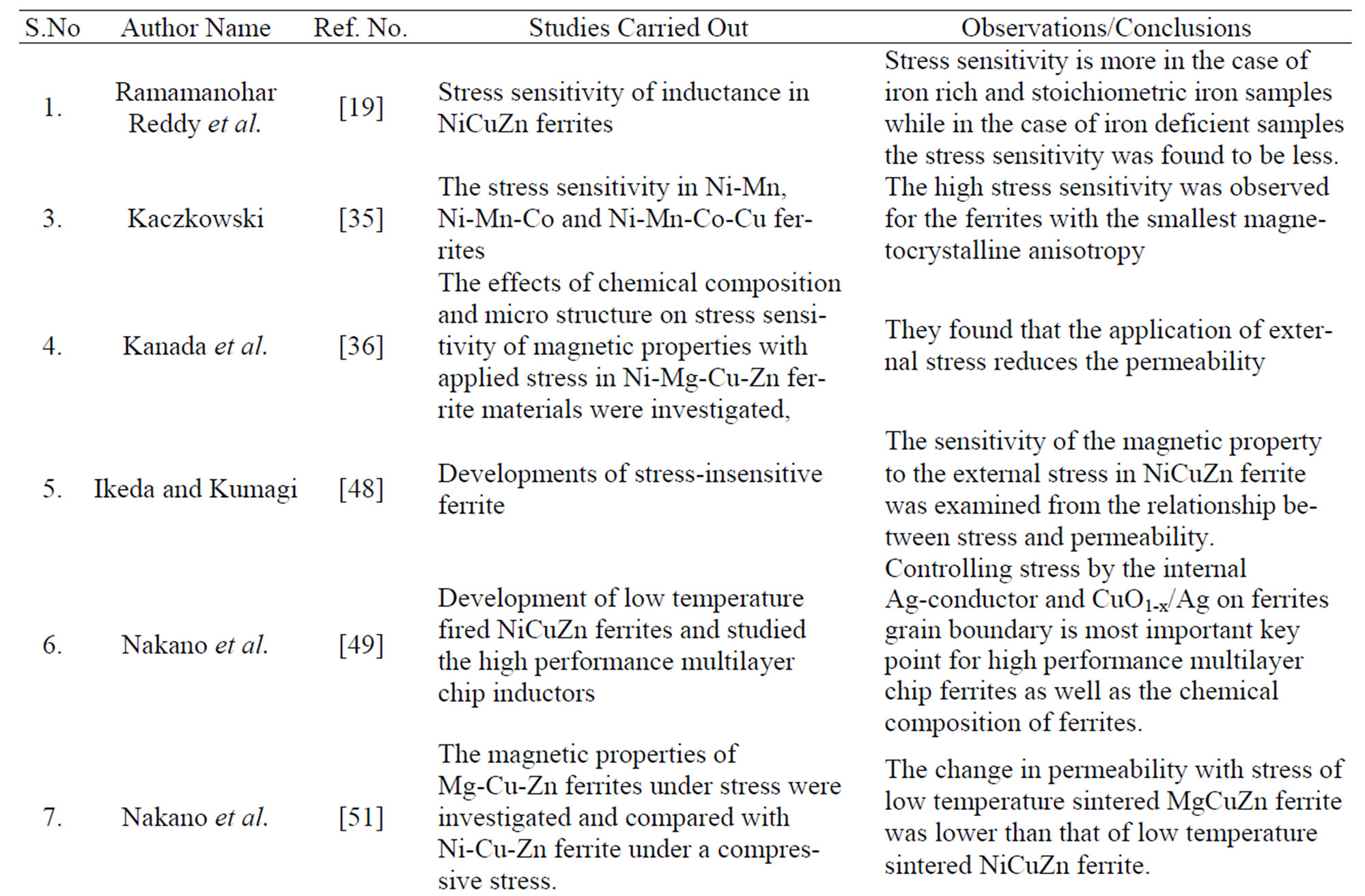
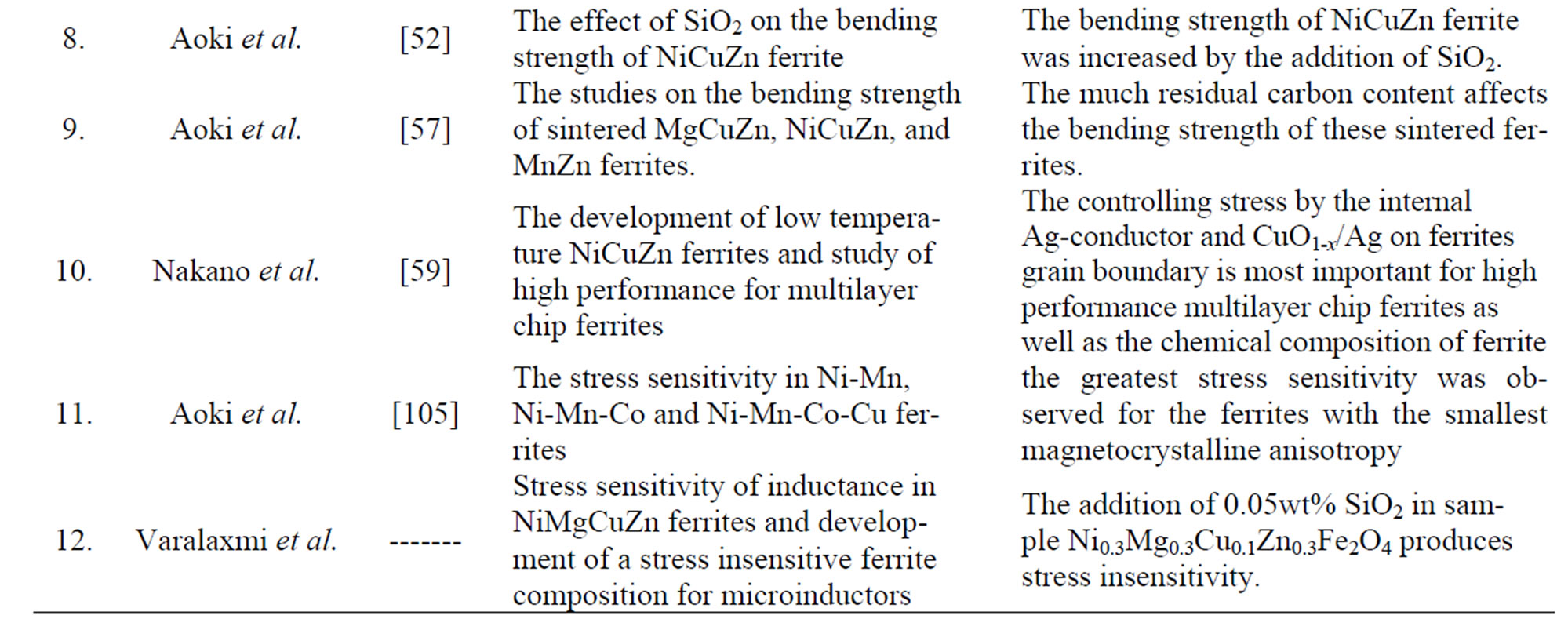
7. Acknowledgements
This work was financially supported by Defence Research and Development Organization (DRDO), under the grants ERIP/ER/0103301/M/01, New Delhi, India. The authors are thankful to the authorities of Sri Krishnadevaraya University, Anantapur for providing the facilities to carry out this programme.
REFERENCES
- X. Qi, J. Zhou, Z. Yue, Z. Gui and L. Li. Key, “Room Temperature Preparation of Nanocrystalline MnCuZn Ferrite Powder by Auto-Combustion of Nitrate-Citrate,” Key Engineering Materials, Vol. 224-226, 2002, pp. 593- 596. doi:10.4028/www.scientific.net/KEM.224-226.593
- T. Nakamura, Y. Okano and S. Miura, “Interfacial Diffusion between Ni-Zn-Cu Ferrite and Ag during Sintering,” Journal of Materials Science, Vol. 33, No. 4, 1998, pp. 1091-1094. doi:10.1023/A:1004344719076
- J. Y. Hsu, W. S. Ko, H. D. Shen and C. J. Chen, “Low Temperature Fired NiCuZn Ferrite,” IEEE Transactions on Magnetics, Vol. 30, No. 6, 1994, pp. 4875-4877. doi:10.1109/20.334251
- S. F. Wang, Y. R. Wang, T. C. K. Yang, P. J. Wang and C. A. Lu, “Densification and Properties of Fluxed Sintered NiCuZn Ferrites,” Journal of Magnetism and Magnetic Materials, Vol. 217, No. 1-3, 2000, pp. 35-43. doi:10.1016/S0304-8853(00)00325-5
- T. Y. Byun, S. C. Beyon, K. S. Hong and C .K. Kim, “Origin of Line Broadening in Co-substituted NiZnCu Ferrites,” Journal of Applied Physics, Vol. 87, No. 9, 2000, pp. 6220-6222. doi:10.1063/1.372660
- J.-H. Nam, W.-G. Hur and J.-H. Oh, “The Effect of Mn Substitution on the Properties of NiCuZn Ferrites,” Journal of Applied Physics, Vol. 81, No. 7, 1997, pp. 4794- 4796. doi:10.1063/1.365466
- Z. Yue, J. Zhou, L. Li and Z. Gui, “Effects of MnO2 on the Electromagnetic Properties of NiCuZn Ferrites Prepared by Sol-Gel Auto-Combustion,” Journal of Magnetism and Magnetic Materials, Vol. 233, No. 13, 2001, pp. 224-229. doi:10.1016/S0304-8853(01)00200-1
- K. O. Low and F. R. Sale, “The Development and Analysis of Property-Composition Diagrams on Gel-Derived Stoichiometric NiCuZn Ferrite,” Journal of Magnetism and Magnetic Materials, Vol. 256, No. 1-3, 2003, pp. 221-226. doi:10.1016/S0304-8853(02)00482-1
- T. Nakamura, “Low-Temperature Sintering of Ni-Zn-Cu Ferrite and Its Permeability Spectra,” Journal of Magnetism and Magnetic Materials, Vol. 16, No. 8, 1997, pp. 285-291. doi:10.1016/S0304-8853(96)00709-3
- S. A. Olofa, “Oscillographic Study of the Dielectric Polarization of Cu-Doped NiZn Ferrite,” Journal of Magnetism and Magnetic Materials, Vol. 131, No. 1-2, 2000, pp. 103-106. doi:10.1016/0304-8853(94)90016-7
- C. S. Kim,W. C. Kim, S. Y. An and S.W. Lee, “Structure and Mössbauer studies of Cu-doped Ni–Zn ferrite,” Journal of Magnetism and Magnetic Materials, Vol. 215- 216, No. 2, 2000, pp. 213-216. doi:10.1016/S0304-8853(00)00120-7
- H. G. Zhang, Z. Ma, J. Zhou, Z. Yue, L. Lu and Z. Gui, “Preparation and Investigation of (Ni0.15Cu0.25Zn0.60) Fe1.96O4 Ferrite with Very High Initial Permeability from Self-Propagated Powders,” Journal of Magnetism and Magnetic Materials, Vol. 213, No. 3, 2000, pp. 304-308. doi:10.1016/S0304-8853(99)00830-6
- S. R. Murthy, “Low Temperature Sintering of NiCuZn Ferrite and Its Electrical, Magnetic and Elastic Properties,” Journal of Materials Science Letters, Vol. 21, No. 8, 2002, pp. 657-660. doi:10.1023/A:1015608625798
- M. Fujimotto, “Inner Stress Induced by Cu Metal Precipitation at Grain Boundaries in Low-TemperatureFired Ni-Zn-Cu Ferrite,” Journal of the American Ceramic Society, Vol. 77, No. 11, 1994, pp. 2873-2878. doi:10.1111/j.1151-2916.1994.tb04517.x
- S. F. Wang, Y. R. Wang, T. C. K. Yang, C. F. Chen, C. A. Lu and C.Y. Huang, “Densification and magnetic properties of Low-Fire NiCuZn Ferrites,” Journal of Magnetism and Magnetic Materials, Vol. 220, No. 2-3, 2000, pp. 129-138. doi:10.1016/S0304-8853(00)00491-1
- S. F. Wang, Y. R. Wang, T.C. K. Yang, C. F. Chen and C. A. Lu, “Effects of Processing on the Densification and Properties of Low-Fire NiCuZn Ferrites,” Scripta Materialia, Vol. 43, No. 3, 2000, pp. 269-274. doi:10.1016/S1359-6462(00)00402-4
- T. Ochiai, et al., “Improved Thermal Stability of Ferromagnetic Tunnel Junctions with a CoFe/CoFeOx/CoFe Pinned Layer,” Journal of the Magnetics Society of Japan, Vol. 27, No. 4, 2003, pp. 307-310.
- M. Kumagai and Y. Ikeda, “Stress-Insensitive Ferrite for Microinductors,” Proceedings of 5th International Conference on Ferrites, Bombay, 1989.
- N. R. Reddy, M. V. Ramana, G. Rajitha, E. Rajagopal, K.V. Sivakumar and V. R. K. Murthy, “Stress Sensitivity of Inductance in NiCuZn Ferrites,” Journal of Magnetism and Magnetic Materials, Vol. 292, 2005, pp. 159-163.
- A. Nakano, H. Momoi and T. Nomura “Effect of Ag on the Microstructure of the Low Temperature Sintered NiCuZn Ferrites,” Proceedings of 6th International Conference on Ferrites, Journal of the Japan Society of Powder and Powder Metallurgy, Kyoto, 1992, pp. 1225-1228.
- A. Ono, T. Muruno and N. Kaihara, Electrical Engineering in Japan, Vol. 28, 1991, p. 5.
- T. Nomura and A. Namano, “New Evolution of Ferrite for Multilayer Chip Components,” Proceedings of 6th International Conference on Ferrites, Journal of the Japan Society of Powder and Powder Metallurgy, Kyoto, 1992, pp. 1198-1201.
- K. Hirota, T. Aoyama, S. Enomoto, M. Yoshinaka and O. Yamaguchi, “Microstructures and magnetic and electric properties of low-temperature sintering Mn-Zn ferrites without and with addition of lithium borosilicate glass,” Journal of Magnetism and Magnetic Materials, Vol. 205, No. 2-3, 1999, pp. 283-289. doi:10.1016/S0304-8853(99)00480-1
- T. Aoyama, K. Hirota and O. Yamaguchi, “Characterization and Low-Temperature Sintering of Reactive Mn-Zn Ferrite Powder,” Journal of the American Ceramic Society, Vol. 79, No. 10, 1996, pp. 2792-2794. doi:10.1111/j.1151-2916.1996.tb09054.x
- E. Rezlscue, et al., “Effect of Copper Oxide Content on Intrinsic Properties of MgCuZn Ferrite,” Materials Research Bulletin, Vol. 33, No. 6, 1998, pp. 915-925. doi:10.1016/S0025-5408(98)00050-6
- H. J. Yan, K. W. Song, S. H. Dar and C. C. Jen, “Low temperature fired NiCuZn ferrite,” IEEE Transactions on Magnetics, Vol. 30, No. 6, 1994, pp. 4875-4877. doi:10.1109/20.334251
- J. G. Koh and C. I. Yu, “The Experimental Studies on Physical Properties by Various Raw Material Compositions and Sintering Temperatures of Cu-Mg-Zn-Fe Ferrites,” The Journal of the Korean Physical Society, Vol. 24, No. 4, 1984, pp. 359-371.
- J. Park, J. Kim and S. Cho, “Effect of Additives on the Magnetic Properties in Mg-Cu-Zn Ferrite,” Journal de Physique IV, Vol. 7, No. C1, 1997, pp. 193-194.
- J. G. Koh and K. U. Kim, “The Effect of Powder Preparation Conditions on Electric Properties, Magnetic Properties and Microstructures of Cu-Mg-Zn-Fe Ferrites,” The Journal of the Korean Physical Society, Vol. 26 No. 6, 1986, pp. 540-549.
- N. Rezlescu, E. Rezlescu, P. D. Popa, L. Craus and L. Rezlescu, “Copper Ions Influence on the Physical Properties of a Magnesium-Zinc Ferrite,” Journal of Magnetism and Magnetic Materials, Vol. 182, No. 1-2, 1998, pp. 199-206. doi:10.1016/S0304-8853(97)00495-2
- X. Qi, J. Zhou, Z. Yue, Z. Gui and L. Li, “Effect of Mn Substitution on the Magnetic Properties of MgCuZn Ferrites,” Journal of Magnetism and Magnetic Materials, Vol. 251, No. 3, 2002, pp. 316-322. doi:10.1016/S0304-8853(02)00854-5
- N. Rezlescu, L. Sachlarie, E. Rezlescu and P. D. Popa, “Influence of PbO and Ta2O5 on Some Physical Properties of MgCuZn Ferrites,” Crystal Research and Technology, Vol. 36, No. 2, 2001, pp. 157-167. doi:10.1002/1521-4079(200102)36:2<157::AID-CRAT157>3.0.CO;2-9
- L. Sachlarie, E. Rezlescu and N. Rezlescu, “Influence of PbO om Some Properties of MgCuZn Ferrites,” Physica Status Solidi (a), Vol. 179, 2000, R1.
- D. N. Bhosale, N. D. Choudari, S. R. Sawant and P. P. Bakare, “Initial Permeability Studies on High Density Cu-Mg-Zn Ferrites,” Journal of Magnetism and Magnetic Materials, Vol. 173, No. 1-2, 1997, pp. 51-58. doi:10.1016/S0304-8853(97)00178-9
- Z. Kaczkowski, “Stress Sensitivity in Ni-Mn, Ni-Mn-Co and Ni-Mn-Co-Cu Ferrites,” Journal of Magnetism and Magnetic Materials, Vol. 41, No. 1-3, 1984, pp. 338-340. doi:10.1016/0304-8853(84)90213-0
- I. Kanada, T. Murase and T. Nomura, “Effect of Chemical Composition and Microstructure on Stress Sensitivity of Ferrites,” Journal of the Japan Society of Powder and Powder Metallurgy, Vol. 48, No. 2, 2001, pp. 136- 139. doi:10.2497/jjspm.48.136
- A. Bienkowski,et al., “Effects of Stress and Its Dependence on Microstructure in Mn-Zn Ferrite for Power Applications,” Journal of Magnetism and Magnetic Materials, Vol. 254-255, 2003, pp. 547-549.
- J. A. Paulsen, A. P. Ring, C. C. H. Lo, J. E. Snyder and D. C. Jiler, “Manganese-Substituted Cobalt Ferrite Magnetostrictive Materials for Magnetic Stress Sensor Applications,” Journal of Applied Physics, Vol. 97, No. 4, 2005, pp. 044502-044502-3. doi:10.1063/1.1839633
- M. I. A. El-Ati and A. Tawafik, “Mechanical and electrical properties of Ni0.65Zn0.35CuxFe2–xO4 ferrite,” Journal of Thermal Analysis and Calorimetry, Vol. 37, No. 11-12, 1991, pp. 2465-2471.
- Czecnoslovak, Journal de Physique IV, Vol. 13, 1963, p. 518.
- B. W. Jong, “Control of Stress Sensitivity in Gadolinium Yttrium Iron Garnets,” Journal of Materials Science, Vol. 13, No. 2, 1978, pp. 459-460. doi:10.1007/BF00647796
- Y. Enokidoy, H. Saitah, N. Sato, T. Nomura and P. Vincenzini, “The Effects of Additives on the Stress and Temperature Dependence of NiCuZn Ferrite Inductance,” Advances in Science Technology, World Ceramics Congress,” Florence, 14-19 June 1998.
- T. Yamaguchi and M. Shingawa, “Effect of Glass Addition and Quenching on the Relation between Inductance and External Compressive Stress in Ni-Cu-Zn Ferrite-Glass Composites,” Journal of Materials Science, Vol. 30, No. 2, 1995, pp. 504-508. doi:10.1007/BF00354418
- H. Meharabi and B. Mintz, “Influence of Tempering on Impact Behaviour of Quenched and Tempered Steels with Low Hardenability,” Materials Science and Technology, Vol. 13, No. 12, 1997, pp. 997-1006.
- D. X. Yang, K. P. Kankolenski, S. Z. Hua, L. J. Swartzendruber, G. E. Hicho and H. D.Chopra, “Evaluation of Mechanical Properties of Magnetic Materials Using a Non-Destructive Method,” IEEE Transactions on Magnetics, Vol. 37, No. 4, 2001, pp. 2758-2760. doi:10.1109/20.951298
- J. T. Vaughn, P. R. Cox, G. P. Rodrgue and G. P.Harrison, “Ferrite phase shifters using stress-insensitive garnet,” IEEE Transactions on Microwave Theory and Techniques, Vol. 43, No. 5, 1995, pp. 1017-1022.
- J. T. Vaughn, P. R. Cox, G.P. Rodrgue and G. P. Harrison, “Ferrite Phase Shifters Using Stress Insensitive Garnet,” Microwave Symposium Digest, IEEE MTT-5, Vol. 1, 1994, pp. 113-116.
- I. Y. Ikeda and M. Kumagi, “Development of StressInsensitive Ferrite,” Journal of the Japan Society of Powder and Powder Metallurgy, Vol. 45, No. 1, 1998, pp. 53-57. doi:10.2497/jjspm.45.53
- A. Nakano, T. Suzuki and H. Momoi, “Development of Nickel-Copper-Zinc Ferrites and Study of Multilayer Chip Ferrites,” Journal of the Japan Society of Powder and Powder Metallurgy, Vol. 49, 2002, pp. 77-86. doi:10.2497/jjspm.49.77
- M. Kumagi and Y. Ikeda, “Stress-insensitive ferrite for microinductors,” Proceedings of 5th International Conference of Ferrites, Bombay, 1989, pp. 625-630.
- A. Nakano. I. Nakahata and T. Murase, “Electromagnetic Properties of Low Temperature Sintering MgCuZn Ferrites,” Journal of the Japan Society of Powder and Powder Metallurgy, Vol. 48, No. 2, 2001, pp. 131-135. doi:10.2497/jjspm.48.131
- T. Akoi, H. Umeda, K. Akasura and T. Musare, “Effect of SiO2 Addition on the Bending Strength of NiCuZn Ferrite,” Journal of the Japan Society of Powder and Powder Metallurgy, Vol. 53, No. 3, 2006, pp. 273-276. doi:10.2497/jjspm.53.273
- M. Kuroda, “A Phenomenological Plasticity Model Accounting for Hydrostatic Stress-Sensitivity and VertexType of Effect,” Mechanics of Materials, Vol. 36, No. 3, 2004, pp. 285-297. doi:10.1016/S0167-6636(03)00023-1
- M. Bruonig, “Numerical Simulation of the Large ElasticPlastic Deformation Behavior of Hydrostatic Stress-Sensitive Solids,” International Journal of Plasticity, Vol. 15, No. 11, 1999, pp. 1237-1264. doi:10.1016/S0749-6419(99)00042-X
- M. Bruonig, “Numerical Analysis and Large Strain Elastic-Viscoplastic Behavior of Hydrostatic Stress-Sensitive Metals,” International Journal of Solids and Structures, Vol. 38, No. 4, 2001, pp. 635- 656.
- M. Bruonig, S. Berger and H. Obrecht, “Numerical Simulation of the Localization Behavior of HydrostaticStress-Sensitive Metals,” International Journal of Mechanical Sciences, Vol. 42, No. 11, 2006, pp. 2147-2166. doi:10.1016/S0020-7403(00)00002-3
- T. Aoki, T. Murase and T. Nomura, “Effect of Residual Carbon on Bending Strength of Sintered Ferrite,” Journal of the Japan Society of Powder and Powder Metallurgy, Vol. 48, No. 2, 2001, pp. 140-144. doi:10.2497/jjspm.48.140
- I. Nakahata, T. Murase and A. Nakano, “The Study of Low Temperature Sintering MgCuZn Ferrites,” Journal of the Japan Society of Powder and Powder Metallurgy, Vol. 48, No. 2, 2001, pp. 126-130. doi:10.2497/jjspm.48.126
- A. Nakano, T. Suzuki and H. Momoi, “Development of Nickel-Copper-Zinc Ferrites and Study of Multilayer Chip Ferrites,” Journal of the Japan Society of Powder and Powder Metallurgy, Vol. 49, No. 2, 2002, pp. 77-86. doi:10.2497/jjspm.49.77
- S. Murayamna, M. Kumagi and Y. Ikeda, “High-Strength NiCuZn Ferrite for Surface Mount Device,” Proceedings of 6th International Conference on Ferrites, Kyoto, 1992, pp. 366-369.
- D. Temme, et al., “Lithium Ferrites for Microwave Devices,” Microwave Symposium Digest, GMTT International, Vol. 71, No. 1, 1971, pp. 74-75.
- G. Mian and O. Yamaguchi, “The Effect of Microstructure on Residual Stress-Producing and -Releasing Mechanisms in Ceramics Processing,” Journal of Mechanical Sciences, Vol. 26, No. 7, 1991, pp. 1775-1780. doi:10.1007/BF00543601
- J. Smit and H. P. J. Wijn, “Ferrites,” Philips Technical Library, Eindhoven, 1959.

